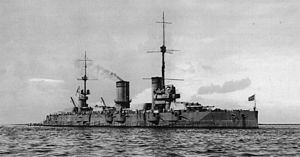 Gangut at anchor in Helsinki, Finland, 1915
| |
| History | |
|---|---|
| Name | Gangut |
| Namesake | Battle of Gangut |
| Builder | Admiralty Works, Saint Petersburg |
| Laid down | 16 June 1909[Note 1] |
| Launched | 20 October 1911 |
| Commissioned | 11 January 1915 |
| Name | Oktyabrskaya Revolutsiya |
| Namesake | October Revolution |
| Acquired | November 1917 |
| Renamed | 27 June 1925 |
| Reclassified | 24 July 1954 |
| Stricken | 17 February 1956 |
| Nickname(s) | Oktyabrina |
| Honors and awards | Order of the Red Banner 22 July 1944 |
| General characteristics (as built) | |
| Class and type | Gangut-class battleship |
| Displacement | 24,800 tonnes (24,400 long tons; 27,300 short tons) |
| Length | 181.2 m (594 ft) |
| Beam | 26.9 m (88 ft) |
| Draft | 8.99 m (29.5 ft) |
| Propulsion |
|
| Speed | 24.1 knots (44.6 km/h; 27.7 mph) (on trials) |
| Range | 3,200 nautical miles (5,900 km; 3,700 mi) at 10 knots (19 km/h; 12 mph) |
| Complement | 1,149 |
| Armament |
|
| Armor |
|
Gangut (Russian: Гангут) was both the lead ship of the Gangut-class dreadnoughts of the Imperial Russian Navy built before World War I and the last of her class to be completed. She was named after the Russian victory over the Swedish Navy in the Battle of Gangut in 1714. She was completed during the winter of 1914–1915, but was not ready for combat until mid-1915. Her role was to defend the mouth of the Gulf of Finland against the Germans, who never tried to enter, so she spent her time training and providing cover for minelaying operations. Her crew joined the general mutiny of the Baltic Fleet after the February Revolution and joined the Bolsheviks in 1918. She was laid up in 1918 for lack of manpower and not recommissioned until 1925, by which time she had been renamed Oktyabrskaya Revolutsiya (Russian: Октябрьская революция: October Revolution).
She was reconstructed between 1931 and 1934 with new boilers, fire-control systems and greatly enlarged superstructures. During the Winter War she bombarded Finnish coastal artillery positions once. Her anti-aircraft armament was greatly reinforced in early 1941, just before Operation Barbarossa. She provided gunfire support against the Germans during the Siege of Leningrad despite being bombed three times and under repair for a year. Retained on active duty after the war she became a training ship in 1954 before being struck off the Navy List in 1956 and slowly scrapped.
Cite error: There are <ref group=Note> tags on this page, but the references will not show without a {{reflist|group=Note}} template (see the help page).